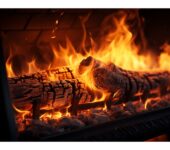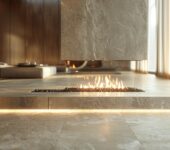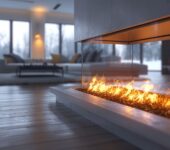Table of Contents
Cozying up by the fire with a glass of red wine in hand is one of your favorite winter pastimes. And fortunately, when your fireplace is properly maintained, the experience can be just as safe as it is comforting.
In fact, research shows that chimney and fireplace fires have dropped 88% from three decades ago due to the increased attention given to fireplace safety.
The question is, how exactly can you continue to maintain a safe fireplace in the cold seasons ahead? Here’s a rundown of the top home fire safety tips to confidently enjoy your fireplace long-term.
Let’s get started!
Top Home Fire Safety Tips Include Performing Chimney Inspections
One of the essential tips for preventing home fires when you have a fireplace is to inspect your chimney every two years at a minimum. You can do this with the help of a reliable chimney sweep, which can look at your fireplace and your chimney. They can also clean the chimney.
Cleaning your chimney is essential, given that failing to clean chimneys remains a leading cause of home heating-related fires.
Your chosen chimney sweep should insert a brush into your fireplace and up your chimney. They will do this to remove debris and soot from your bricks. Afterward, the sweep will clean multiple components of your fireplace, including its firebox (the space where your logs burn), smoke shelf, smoke chamber, damper, and flue.
The chimney cleaning process should take about an hour. Once this process is finished, your chimney sweep may light a tiny fire in your fireplace to perform a fireplace smoke test. This step will help to ensure that your fireplace has been thoroughly cleaned and is, therefore, safe to use.
After your chimney sweep has completed your job, maintain a record of all of the reports you receive from them. In addition, ask the sweep for guidance on using your fireplace and how to spot any issues with it down the road.
Protect the Inside of Your Home
Another fire prevention tip during fireplace season is installing carbon monoxide and smoke detectors on all levels of your house. This way, you can discover a fire or carbon monoxide problem early on while there is still time to evacuate your home safely.
After installing detectors, take time to test the units each month. In addition, they change their batteries each year.
Protect the Exterior of Your Home
Along with safeguarding your home’s interior during fireplace season, you can take steps to keep the outside of your home safe.
For starters, keep your roof free of debris, such as leaves and pine needles. If trees shed leaves on the roof regularly, you can use a leaf-blowing machine to eliminate the debris.
In addition, you may want to cover your chimney with a spark arrestor made of mesh material. This device will prevent embers and sparks from going onto the roof and possibly starting a blaze.
Finally, stack the firewood you plan to put in your fireplace about 30 feet from your house, at the very least. Your home may be built of brick or concrete, but it would still be risky to leave wood stacks immediately beside the house. That’s because firewood is highly flammable, so it can cause the place to catch fire if lightning strikes.
Starting Your Fire
When you’re ready to use your fireplace, start by placing paper at the bottom of your fireplace. Then, put small logs/ wood pieces on top. Afterward, add more significant wood pieces on top of the smaller pieces.
Next, use a match or lighter to light your paper. After this, use a long wood piece or fire poker to move logs and sticks around so that everything burns simultaneously.
Feel free to add sticks to keep your fire growing if it appears that the fire may go out. However, avoid overfeeding your fire during this process.
If you put too many logs in the fire, this may cause the fire to grow too large, or it might smother your flames. At the same time, you should feed your fire practically and steadily to keep it going strong.
After-Fire Care
Let’s say you’re finished enjoying the fire for the night. Remember that the coals in your fireplace will still be hot long after you’ve extinguished your fire.
In light of this, you should scoop your ashes into a container made of metal using a shovel. Once you complete this step, store your container far away from wood floors and combustible surfaces. Alternatively, you can dispose of your ashes down a small trap door toward the back of your fireplace if your fireplace has one.
Avoid cleaning up your ashes by using a household vacuum cleaner, as the ashes may contain live coals that can cause damage to the cleaner. Also, get into the habit of cleaning your firebox once per week during the seasons you’ll be using your fireplace.
How We Can Help
How you handle the maintenance and use of your fireplace during the cold-weather seasons will ultimately impact your home’s safety. Fortunately, the top home fire safety steps—including inspecting your chimney, installing smoke detectors, keeping your roof debris free, and adequately starting and cleaning up after a fire—can help keep fires at bay.
At Dreiffus Fireplaces, we are proud to carry only the best fireplaces from leading industry manufacturers and major brands. Get in touch with us to learn more about our fireplace offerings, and place an order today!
Latest Articles
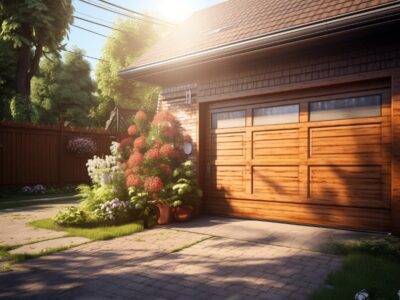
How Much Do Wooden Garage Doors Cost?
Table of Contents1 Factors That Affect the Cost of Wooden Garage Doors2 Average Cost of Wooden Garage Doors3 Additional Costs to Consider4 Benefits of Choosing
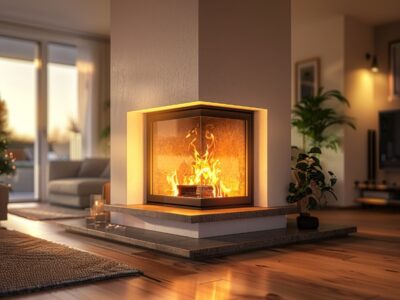
Why Does My Fireplace Have So Much Cold Air Infiltration?
Table of Contents1 Understanding Cold Air Infiltration in Fireplaces2 What Causes Cold Air Infiltration in Fireplaces?3 How to Detect Cold Air Infiltration in Your Fireplace?4
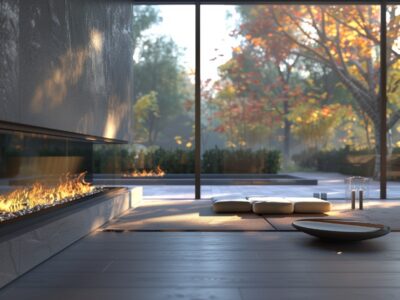
Can I Have A Fireplace In My Sunroom?
Table of Contents1 Pros and Cons of Having a Fireplace in a Sunroom2 Types of Fireplaces for Sunrooms3 Factors to Consider Before Installing a Fireplace








